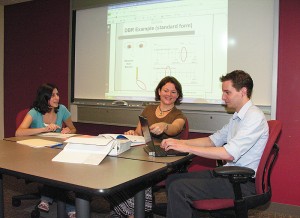
Schools gather reams of test data to measure how well students read or do math, but can they also gather reliable data on how children behave?
Yes, says a researcher in the Neag School of Education who has helped develop a rating system that offers teachers a practical method for charting and improving their students’ behavior.
Sandra Chafouleas, an associate professor in the Department of Educational Psychology, is recognized as a national authority on Direct Behavior Rating, a tool designed to detect patterns of both positive and negative classroom behavior.
The need for better data on student behavior, according to Chafouleas, is “part of a growing emphasis on the importance of mental health and how social, emotional, and behavioral skills fit into school systems.”
Not only are schools accountable for students’ academic progress, they are increasingly expected to develop children’s behavioral and social skills, too, she says.
“The expectations on schools have changed dramatically,” she says. “In order to pay attention to behavior in a more pro-active way, we need to be able to assess it directly. If we wait until a student gets an office disciplinary referral, there’s already a problem.”
Classroom discipline has been at or near the top of the list of concerns by Americans in annual Gallup Polls, yet schools often have little reliable data on patterns of student behavior. Although some behavioral tests do exist, many of those tests are time-consuming, are not designed specifically for schools, and do not screen classroom behavior quickly, Chafouleas says.
In 2006, Chafouleas and researchers from the University of Minnesota and East Carolina University began work under a four-year, $1.7 million grant from the U.S. Department of Education to examine Direct Behavior Rating as a means of assessing classroom behavior more easily. Chafouleas is the project director.
“She is one of the first researchers to figure out how to address the excessive and unsustainable amounts of effort required by educators and school psychologists to collect behavioral assessment information,” says George Sugai, director of UConn’s Center for Behavioral Education and Research.
Her project has become a focal point for the study of Direct Behavior Rating. Chafouleas and her colleagues wrote a series of articles about Direct Behavior Rating for a special issue of the academic journal Assessment for Effective Intervention published in September.
Chafouleas describes Direct Behavior Rating as a simple method of classroom observation similar to medical rating scales in which physicians ask patients to rate their level of pain.
“We’ve settled on a zero-to-10 scale” for Direct Behavior Rating, Chafouleas says. Teachers rate students at regular intervals, such as the end of each class period. The observations include not only disruptive behavior but positive conduct, such as paying attention, following directions, and acting respectfully.
Although similar approaches have been tried in the past, Chafouleas says there has been little research on whether such methods produce reliable data. “We are finding out that it does work,” she says.
The researchers are studying ways to train teachers to improve the accuracy of their observations. In addition, Chafouleas has been working with Professor Steven Demurjian and his students in UConn’s computer science and engineering department to develop web-based software for collecting and reporting the data.
The idea behind Direct Behavior Rating is to help teachers get an accurate picture of classroom behavior instead of simply relying on sporadic, subjective judgments.
“It’s quick, it’s easy, it’s immediate,” says Gussie Gilberti, a Colchester Elementary School teacher who has been testing Direct Behavior Rating along with fellow kindergarten teacher Sue Arntsen. Last year, the teachers used the rating to assess behavior with an entire class. This year, they are using it to focus on a single student, a kindergarten girl who has shown antisocial, aggressive behavior.
The teachers say the method has helped them identify what triggers the girl’s outbursts and what type of classroom organization works best for her. “It helped us look at structuring her day,” Gilberti says.
Chafouleas, a former school psychologist, says, “I sat around many team meetings focusing on ‘What’s wrong with Johnny?’” If schools had gathered enough data, they could have taken steps to teach Johnny a better way to do something, she says.
With the data, she says, “you’ve got accountability to show the practices you’re doing in your classroom are working.”
Chafouleas, 37, came to UConn in 2000 and quickly established herself as a prolific young researcher. She has written or co-authored more than 70 scholarly articles and has won research grants totaling nearly $3.5 million.
The Neag School selected her for its Outstanding Young Investigator Award in 2003 and the UConn Alumni Association this year named her the winner of the Faculty Excellence in Teaching (Graduate Level) Award.


